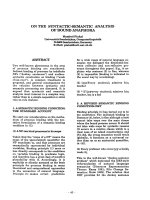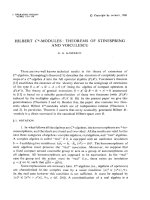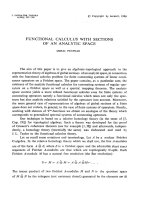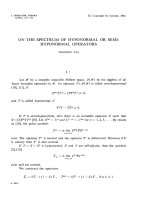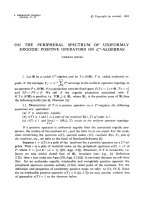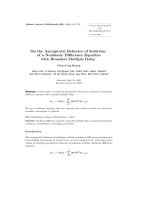Báo cáo toán học: "n the non–existence of certain hyperovals in dual Andr´ planes of order 22h e" pot
Bạn đang xem bản rút gọn của tài liệu. Xem và tải ngay bản đầy đủ của tài liệu tại đây (92.85 KB, 5 trang )
On the non–existence of certain hyperovals in
dual Andr´e planes of order 2
2h
Angela Aguglia
Dipartimento di Matematica
Politecnico di Bari
Via Orabona 4
I–70125 Bari, Italy
Luca Giuzzi
∗
Dipartimento di Matematica
Facolt`a di Ingegneria
Universit`a degli Studi di Brescia
Via Valotti 9
I-25133 Brescia, Italy
Submitted: Jul 31, 2008; Accepted: Oct 13, 2008; Published: Oct 20, 2008
Mathematics Subject Classification: 51E15, 51E21
Abstract
No regular hyperoval of the Desarguesian affine plane AG(2, 2
2h
), with h > 1, is
inherited by a dual Andr´e plane of order 2
2h
and dimension 2 over its kernel.
1 Introduction
The general question on existence of ovals in finite non–Desarguesian planes is still open
and appears to be difficult. It has been shown by computer search that there exist some
planes of order 16 without ovals; see [11]. On the other hand, ovals have been constructed
in several finite planes; one of the most fruitful approaches in this search has been that
of inherited oval, due to Korchm´aros [5, 6].
Korchm´aros’ idea relies on the fact that any two planes π
1
and π
2
of the same order
have the same number of points and lines; thus their point sets, as well as some lines,
may be identified. If Ω is an oval of π
1
, it might happen that Ω, regarded as a point set,
turns also out to be an oval of π
2
, although π
1
and π
2
differ in some (in general several)
point–line incidences; in this case Ω is called an inherited oval of π
2
from π
1
; see also [2,
Page 728].
In practice, it is usually convenient to take π
1
to be the Desarguesian affine plane
AG(2, q) of order a prime power q. The case in which π
2
is the Hall plane H(q
2
) of order
q
2
was investigated in [5], and inherited ovals were found. For q odd, this also proves the
∗
Research supported by the Italian Ministry MIUR, Strutture geometriche, combinatoria e loro ap-
plicazioni.
the electronic journal of combinatorics 15 (2008), #N37 1
existence of inherited ovals in the dual plane of H(q
2
), which is a Moulton plane M(q
2
)
of the same order.
Moulton planes have been originally introduced in [10], by altering some of the lines
of a Desarguesian plane constructed over the real field, while keeping the original point
set fixed. In particular, each line of the Moulton plane turns out to be either a line of the
original plane or the union of two half–lines of different slope with one point in common.
This construction, when considering planes of finite order q
2
, may be carried out as
follows. Let || · || denote the norm function
|| · || :
GF(q
2
) → GF(q)
x → x
q+1
Take a proper subset U of GF(q)
and consider the following operation defined over the
set GF(q
2
)
a b =
ab if ||b|| ∈ U
a
q
b if ||b|| ∈ U.
The set (GF(q
2
), +, ) is a pre-quasifield which is a quasifield for U = {1}. Every pre-
quasifield coordinatizes a translation plane; see [4, Section 5.6]. In our case this translation
plane is an affine Andr´e plane A(q
2
) of order q
2
and dimension 2 over its kernel; see [8].
In the case in which U consists of a single element of GF(q
2
) the translation plane is the
affine Hall plane of order q
2
and its dual plane is the affine Moulton plane of order q
2
.
For details on these planes see [3, 8].
Write M
U
(q
2
) = (P, L) for the incidence structure whose the point–set P is the same
as that of AG(2, q
2
), and whose lines in L are either of the form
[c] = {P (x, y) : x = c, y ∈ GF(q
2
)}
or
[m, n] = {P (x, y) : y = m x + n}.
The affine plane M
U
(q
2
) is the dual of an affine Andr´e plane A(q
2
) of order q
2
. Completing
M
U
(q
2
) with its points at infinity in the usual way gives a projective plane M
U
(q
2
) called
the projective closure of M
U
(q
2
).
Write Φ = {P (x, y) : ||x|| ∈ U} and Ψ = {P (x, y) : ||x|| ∈ U}. Clearly, P = Φ ∪ Ψ.
If an arc A of P G(2, q
2
) is in turn an arc in M
U
(q
2
) then, A is an inherited arc of
M
U
(q
2
).
Any hyperoval of the Desarguesian projective plane P G(2, q
2
) obtained from a conic
by adding its nucleus is called regular. Let consider the set Ω of the affine points in
AG(2, q
2
) of a regular hyperoval. If Ω ⊆ Φ, that is for each point P (x, y) ∈ Ω the norm
of x is an element of GF(q) \ U, then Ω is clearly an inherited hyperoval of M
U
(q
2
).
In [1, Theorem 1.1], it is proven that for q > 5 an odd prime power, any arc of the
Moulton plane M
t
(q
2
) with t ∈ GF (q), obtained as C
= C ∩ Φ, where C is an ellipse in
AG(2, q
2
) is complete.
In this paper the case where q is even and |U| <
q
4
− 1 is addressed. We prove the
following.
the electronic journal of combinatorics 15 (2008), #N37 2
Theorem 1. Suppose Ω to be the set of the affine points of a regular hyperoval of the
projective closure PG(2, 2
2h
) of AG(2, 2
2h
), with h > 1. Then, Ω
∗
= Ω ∩ Φ is a complete
arc in the projective closure of M
U
(2
2h
).
Theorem 2. The arc consisting of the affine points of a regular hyperoval of PG(2, 2
2h
)
with h > 1 is not an inherited arc in the projective closure of M
U
(2
2h
).
We shall also see that any oval arising from a regular hyperoval of AG(2, 2
2h
) by
deleting a point cannot be inherited by M
U
(2
2h
). The hypothesis on Ω being a regular
hyperoval cannot be dropped; see [11] for examples of hyperovals in the Moulton plane of
order 16.
2 Proof of Theorem 1
We begin by showing the following lemma, which is a slight generalisation of Lemma 2.1.
in [1].
Lemma 3. Let q be any prime power. A pencil of affine lines L(P ) of M
U
(q
2
) with
centre P (x
0
, y
0
), either consists of lines of a Baer subplane B of P G(2, q
2
), or is a pencil
in AG(2, q
2
) with the same centre, according as ||x
0
|| ∈ U or not. In particular, in the
former case, the q
2
+ 1 lines in L(P ) plus the q vertical lines X = c with ||c|| = x
q+1
0
and
c = x
0
are the lines of B.
Proof. The pencil L(P ) consists of the lines
r
m
: y = m x − m x
0
+ y
0
,
with m ∈ GF (q
2
), plus the vertical line : x = x
0
. First suppose ||x
0
|| ∈ U. In this case
m x
0
= m
q
x
0
and the line r
m
of L(P ) corresponds to the point (m, m
q
x
0
− y
0
) in the
dual of M
U
(q
2
), which is an Andr´e plane.
As m varies over GF (q
2
) we get q
2
affine points of the Baer subplane B
in P G(2, q
2
)
represented by y = x
q
x
0
− y
0
. The points at infinity of B
are those points (c) such that
c
q+1
= ||x
0
||. As the dual of a Baer subplane is a Baer subplane, it follows that the lines
in L(P ) are the lines of a Baer subplane B in PG(2, q
2
). More precisely, the lines in L(P )
plus the q vertical lines x = c, ||c|| = ||x
0
||, with c = x
0
, are the lines of B.
In the case in which ||x
0
|| /∈ U the line r
m
: y = m x − mx
0
+ y
0
in L(P ) corresponds
to the point
(m, mx
0
− y
0
)
in the dual of M
U
(q
2
). As m varies over GF (q
2
) we get q
2
affine points in AG(2, q
2
) on
the line y = x
0
x − y
0
. Finally, the dual of infinite point of y = x
0
x − y
0
is the vertical line
through P (x
0
, y
0
). The result follows.
Let Ω denote a regular hyperoval in AG(2, q
2
), q = 2
h
, h > 1. It will be shown that for
any point P (x
0
, y
0
) with ||x
0
|| ∈ U there is at least a 2–secant to Ω
= Ω ∩ Φ in M
U
(q
2
)
through P .
the electronic journal of combinatorics 15 (2008), #N37 3
Assume B to be the Baer subplane in P G(2, q
2
) containing the lines of the pencil L(P )
in M
U
(q
2
) and the q vertical lines X = c with ||c|| = x
q+1
0
, c = x
0
. Write ∆ for the set of
all points of Ω not covered by a vertical line of B and also let n = |∆| and m = q
2
+ 2− n.
The vertical lines of B cover at most 2(q + 1) points of Ω; thus, q
2
− 2q ≤ n ≤ q
2
+ 2. We
shall show that there is at least a line in B meeting ∆ in two points.
Let T ∈ ∆; since T ∈ B, there is a unique line
T
of B through T . Every point
Q ∈ Ω \ ∆ lies on at most q + 1 − (m − 1) = q − m + 2 lines
T
with T ∈ ∆. Suppose by
contradiction that for every T ∈ ∆,
T
∩ Ω = {T, Q}, with Q ∈ Ω \ ∆.
The total number of lines
T
obtained as Q varies in Ω \ ∆ does not exceed m(q − m + 2).
So, n = q
2
− m + 2 ≤ m(q − m + 2). As m is a non–negative integer, this is possible only
for q = 2.
Since
T
is not a vertical line, it turns out to be a chord of Ω
∗
in M
U
(q
2
) passing
through P (x
0
, y
0
). This implies that no point P (x
0
, y
0
) ∈ Ψ may be aggregated to Ω
in
order to obtain an arc.
This holds true in the case P (x
0
, y
0
) ∈ Φ. In AG(2, q
2
) there pass (q
2
+ 2)/2 secants
to Ω through a point P (x
0
, y
0
) /∈ Ω and, hence, N = (q
2
+ 2)/2 − s secants to Ω
∗
, where
s ≤ 2(q + 1)|U|. So by the hypothesis |U| < q/4 − 1, we obtain N > 0; this implies that
no point P (x
0
, y
0
) ∈ Φ may be aggregated to Ω
in order to obtain a larger arc. The
same argument works also when P is assumed to be a point at infinity. Theorem 1 is thus
proved.
3 Proof of Theorem 2
We shall use the notion of conic blocking set; see [7]. A conic blocking set B is a set
of lines in a Desarguesian projective plane met by all conics; a conic blocking set B is
irreducible if for any line of B there is a conic intersecting B in just that line.
Lemma 4 (Theorem 4.4,[7]). The line–set
B = {y = mx : m ∈ GF(q)} ∪ {x = 0}
is an irreducible conic blocking set in PG(2, q
2
), where q = 2
h
, h > 1.
Lemma 5. Let Ω be a regular hyperoval of P G(2, q
2
), with q = 2
h
, h > 1. Then, there
are at least two points P (x, y) in Ω such that ||x|| ∈ U.
Proof. To prove the lemma we show that the set Ψ
= Ψ ∪ Y
∞
, is a conic blocking set.
We observe that the conic blocking set of Lemma 4 is actually a degenerate Hermitian
curve of PG(2, q
2
) with equation x
q
y − xy
q
= 0. Since all degenerate Hermitian curves
are projectively equivalent, this implies that any such a curve is a conic blocking set.
On the other hand, Ψ
may be regarded as the union of degenerate Hermitian curves of
equation x
q+1
= cz
q+1
, as c varies in U. Thus, Ψ
is also a conic blocking set. Suppose
the electronic journal of combinatorics 15 (2008), #N37 4
now Ω = C ∪ N, where C is a conic of nucleus N. Take P ∈ Ψ
∩ C. If P = Y
∞
then at
most one of the vertical lines X = c, with ||c|| ∈ U, is tangent to C; hence there are at
least q points P
(x, y) ∈ Ω with ||x|| ∈ U and thus |Ψ ∩ Ω| ≥ q.
Next, assume that P = P (x, y) ∈ Ψ. If the line [x] is secant to C the assertion
immediately follows. If the line [x] is tangent to C then the nucleus N lies on [x]. Now,
either N is an affine point in Ψ or N = Y
∞
. In the former case we have |Ψ ∩ Ω| ≥ 2; in
the latter, the lines X = c with ||c|| ∈ U are all tangent to C; hence, there are at least
other q + 1 points P
(x, y) ∈ Ω such that ||x|| ∈ U.
Now, let Ω be a regular hyperoval in AG(2, q
2
), with q = 2
h
and h > 1. From Lemma
5 we deduce that |Ω
∗
∩ Φ| ≤ q
2
; furthermore, Theorem 2 guaranties that Ω
∗
is a complete
arc in the projective closure of M
U
(q
2
), whence Theorem 2 follows.
Remark 1. The largest arc of M
U
(q
2
) contained in a regular hyperoval of AG(2, q
2
), with
q = 2
h
, has at most q
2
points; in particular any oval which arises from a hyperoval of
AG(2, q
2
) by deleting a point cannot be an oval of M
U
(q
2
). For an actual example of a
q
2
–arc of M
U
(q
2
) coming from a regular hyperoval of AG(2, q
2
) see [9]. This also shows
that the result of [5] cannot be extended to even q.
References
[1] V. Abatangelo, B. Larato, Canonically Inherited Arcs in Moulton Planes of Odd
Order, to appear on Innovations in Incidence Geometry.
[2] C.J. Colbourn, J.H. Dinitz, Handbook of Combinatorial Designs (2nd ed.), Chapman
& Hall (2007).
[3] P. Dembowski, Finite Geometries, Springer (1968).
[4] N.L. Johnson, V. Jha, M. Biliotti, Handbook of finite translation planes. Pure and
Applied Mathematics, 289 Chapman & Hall/CRC, Boca Raton, FL, (2007).
[5] G. Korchm´aros, Ovali nei piani di Moulton d’ordine dispari, Colloquio Internazionale
sulle Teorie Combinatorie (Rome, 1973), Tomo II, 395–398. Atti dei Convegni Lincei,
No. 17, Accad. Naz. Lincei, Rome (1976).
[6] G. Korchm´aros, Ovali nei piani di Hall di ordine dispari, Atti Accad. Naz. Lincei
Rend. Cl. Sci. Fis. Mat. Natur. (8) 56 (1976) no. 3, 315–317.
[7] L. D. Holder, Conic blocking sets in Desarguesian projective planes, J. Geom. 80
(2004), no. 1-2, 95–105.
[8] D.Hughes, F. Piper, Projective planes, Springer (1973).
[9] G. Menichetti, k–archi completi in piani di Moulton d’ordine q
m
, Atti Accad. Naz.
Lincei Rend. Cl. Sci. Fis. Mat. Natur. (8) 60 (1976), no. 6, 775–781.
[10] F.R. Moulton, A simple non–desarguesian plane geometry, Trans. Am. Math. Soc. 3
(1902), 192–195.
[11] T. Penttila, G.F. Royle, M.K. Simpson, Hyperovals in the known projective planes of
order 16, J. Combin. Des. 4 (1996), no. 1, 59–65.
the electronic journal of combinatorics 15 (2008), #N37 5
